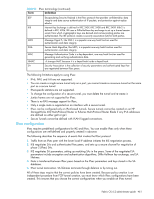HP StorageWorks 8/80 HP StorageWorks Fabric OS 6.2 administrator guide (5697-0 - Page 463
QoS implementation over FCIP
 |
View all HP StorageWorks 8/80 manuals
Add to My Manuals
Save this manual to your list of manuals |
Page 463 highlights
enterprise-class platforms. The HP StorageWorks 400 Multi-Protocol Router and the B-Series Multi-Protocol Router Blade both have 16 physical Fibre Channel ports and 2 physical GbE ports. NOTE: The FCIP Tunneling Service for the HP StorageWorks 400 Multi-Protocol Router and B-Series Multi-Protocol Router Blade is not compatible with the XPath FCIP service, nor is it compatible with any other vendor's implementation. QoS implementation over FCIP Quality of Service (QoS) refers to policies for handling differences in data traffic. These policies are based on data characteristics and delivery requirements. For example, ordinary data traffic is tolerant of delays and dropped packets, but voice and video data are not. QoS policies provide a framework for accommodating these differences in data as it passes through a network. Fabric OS versions 6.0.0 and later provide for Fibre Channel QoS through internal QoS priorities. Those priorities can be mapped to TCP/IP network priorities. There are two options for TCP/IP network-based QoS: • Layer three DiffServ code Points (DSCP). • VLAN tagging and Layer two class of service (L2CoS). DSCP quality of service Layer three class of service DiffServ Code Points (DSCP) refers to a specific implementation for establishing QoS policies as defined by RFC2475. DSCP uses six bits of the Type of Service (TOS) field in the IP header to establish up to 64 different values to associate with data traffic priority. DSCP settings are useful only if IP routers are configured to enforce QoS policies uniformly within the network. IP routers use the DSCP value as an index into a Per Hop Behavior (PHB) table. Control connections and data connections may be configured with different DSCP values. Before configuring DSCP settings, determine if the IP network you are using implements PHB, and consult with the network administrator to determine the appropriate DSCP values. L2CoS quality of service Devices in physical LANs are constrained by LAN boundaries. They are usually in close proximity to each other, and share the same broadcast and multicast domains. Physical LANs often contain devices and applications that have no logical relationship. Also, when logically related devices and applications reside in separate LAN domains, they must be routed from one domain to the other. A VLAN is a virtual LAN network. A VLAN may reside within a single physical network, or it may span several physical networks. Related devices and applications that are separated by physical LAN boundaries can reside in the same VLAN. Also, a large physical network can be broken down into smaller VLANs. VLAN traffic is routed using 802.1Q-compliant tags within an Ethernet frame. The tag includes a unique VLAN ID, and Class of Service (CoS) priority bits. The CoS priority scheme (also called Layer two Class of Service or L2CoS), uses only the upper three bits of the TOS field, allowing eight priorities. When both DSCP and L2CoS are used If an FCIP tunnel is not VLAN tagged, only DSCP is relevant. If the FCIP tunnel is VLAN tagged, both DSCP and L2CoS are relevant, unless the VLAN is end-to-end, with no intermediate hops in the IP network. The following table shows the default mapping of DSCP priorities to L2Cos priorities per tunnel ID. This may be helpful when consulting with the network administrator. These values may be modified per FCIP tunnel. Table 91 Default Mapping of DSCP priorities to L2Cos Priorities Virtual CIrcuit (VC) DSCP priority/bits L2CoS priority/bits Assigned to: 0 46 / 101110 7 / 111 1 7 / 000111 1 / 001 2 11 / 001011 3 / 011 Class F Medium QoS Medium QoS Fabric OS 6.2 administrator guide 459















